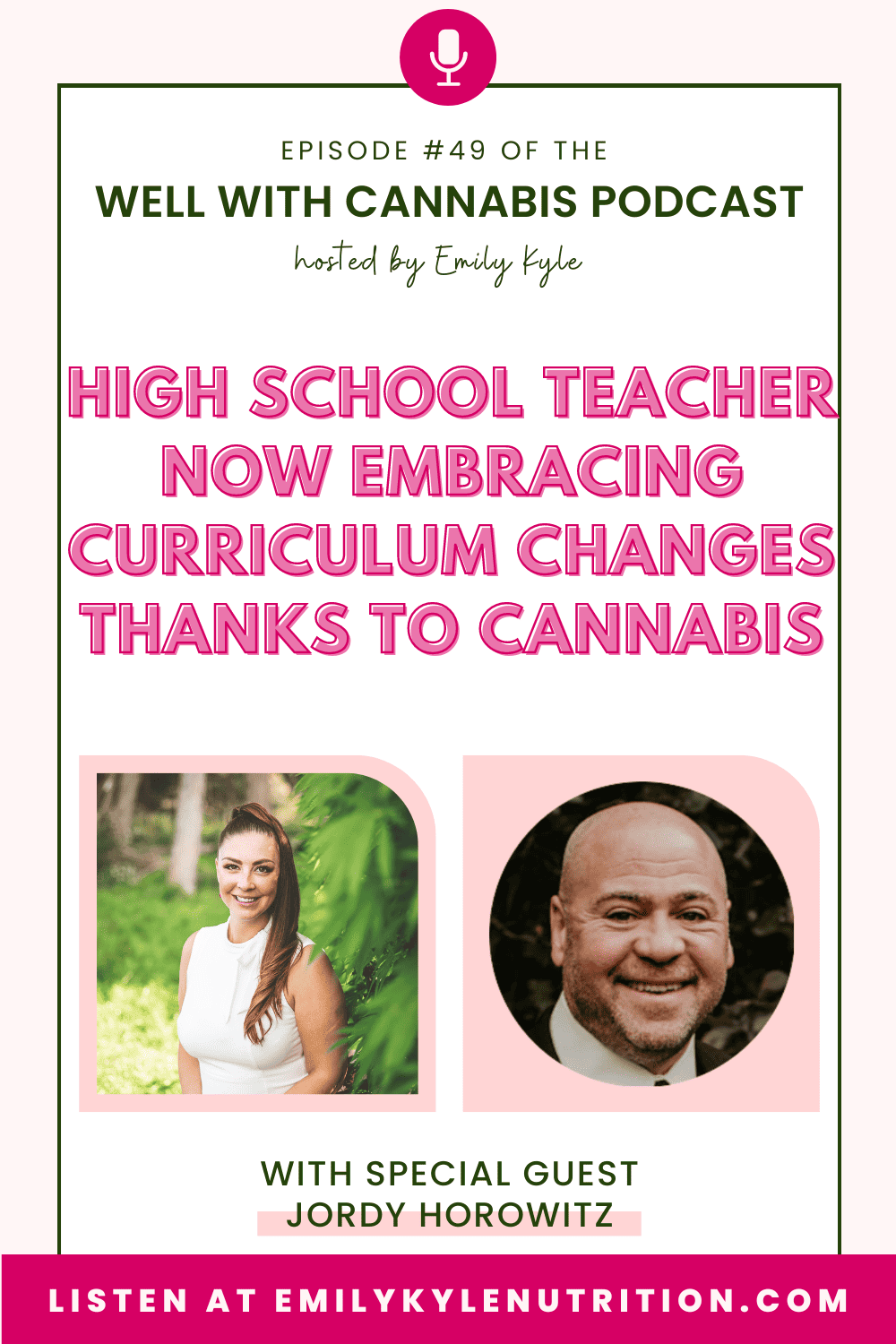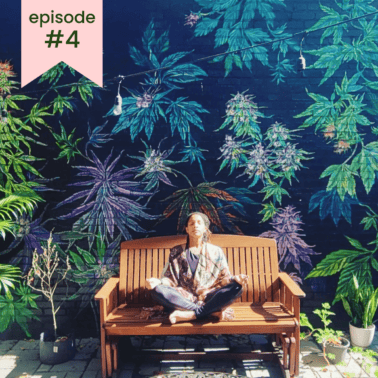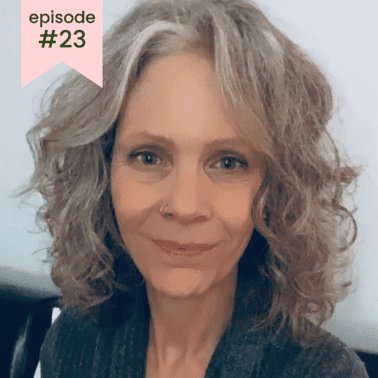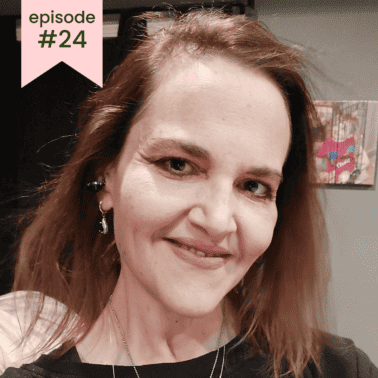Welcome to this thought-provoking conversation with Jordy, who challenges the traditional narrative about cannabis. Jordy takes us through his personal and professional journey, exploring the potential medical benefits of cannabis after experiencing firsthand its therapeutic impact on his chronic pain. Join us as we discuss the transformational power of cannabis, its place in the classroom, and its controversial status in the Federal schedule of drugs.

Table of Contents
Features
- Release Date: Wednesday, September 13, 2023
- Episode Number: Season 1, Episode 49
- Special Guest: Jordy
Listen To The Episode
Click the play button above to listen to the episode.
Listen to all podcast episodes →
Why You Will Love This Episode
In this exciting new episode, Middle School Health Educator Jordy shares his transformative journey from teaching the traditional substance abuse curriculum that vilified cannabis to now embracing and promoting its benefits.
The catalyst for this change was an insightful question from one of his students about the latest research on cannabis. This prompted Jordy to dive deep into the subject, leading him to revise his perspective and his curriculum.
Jordy’s story is about a professional transformation and a personal one. He recounts how he began experiencing severe pain in his legs and joints and how traditional medication failed him.
It was then he decided to explore the therapeutic benefits of cannabis. He experienced pain within a week of using a 3:2 ratio of THC and CBD, which allowed him to resume his active lifestyle, including mountain biking and playing Pickleball.
Since then, Jordy has been a vocal advocate for the potential benefits of cannabis. His health curriculum now includes lessons on the endocannabinoid system and the potential benefits of cannabis for those in need.
He also discusses the different effects of cannabis on the teenage and adult brain and the controversial federal schedule of drugs where cannabis is listed as more dangerous than cocaine and alcohol.
While Jordy doesn’t disclose his personal use of medical cannabis to his students, he reveals that several other teachers in his school have found similar relief through its use.
This episode is a testament to Jordy’s courage in challenging traditional narratives and his dedication to providing his students with the most accurate and up-to-date information.
Full Transcript
Jordy: And that’s what I tell people. It’s not about being high. It’s about being well. And you define what well is for you as sleeping the night? Great. If well means not having pain? Great. Does it mean treating your anxiety? Great. You get to define what well is. And that’s how I approach it with people.
Announcer: Welcome to the Well With Cannabis Podcast, a show dedicated to telling the life-changing stories of those who live well with cannabis all while teaching you how to do the same. Meet your host, Emily Kyle, a registered dietitian nutritionist turned certified holistic cannabis practitioner. Emily changed her life for the better with the help of the cannabis plant, and now she’s committed to helping others do the same.
Tune in each week to hear heartwarming stories and gain the knowledge you need to feel connected, inspired, and supported on your own cannabis journey. Whether you’re a new cannabis consumer or a lifetime lover, you’ll benefit from these uplifting tales of real-life journeys that will show you how you, too, can live your best life well with cannabis.
Disclaimer: Hi there. Before we jump into today’s episode, I wanted to share a note on potentially sensitive content. The episodes on the Well With Cannabis Podcast are created for adult audiences only. We will, at times, cover sensitive topics, including but not limited to suicide, abuse, mental illness, sex, drugs, alcohol, psychedelics, and the obvious use of plant medicine. Explicit language may be used occasionally. Please refrain from watching or listening to the show if you’re likely to be offended or adversely impacted by any of these topics.
The information on this show is for informational and educational purposes only. It does not constitute medical advice. If any of the content on this podcast has brought up anything for you, please reach out or speak to a professional or someone you trust.
Emily: Hello, and welcome back to another episode of the Well with Cannabis Podcast. I’m super excited for today’s conversation. We have Jordy here with us, and he is an educator. I am so excited to get into his story because it’s very interesting. I’m going to let him tell it, but he was not always a cannabis fan. So let’s talk a little bit. Hi, Jordy. Welcome to the show.
Jordy: Thank you, Emily. I’m really happy to be here. And I’m glad you chose my story as one of the stories you wanted to share with other people experiencing the benefits of cannabis.
Emily: Your story really is perfect, and it follows a lot of other people’s stories where cannabis was caught to be something bad, and someone gave you a reason to think about it a little bit differently, and you did. Tell us that story and how it really changed your ideas about cannabis.
Jordy: I am 54 years old, born in 1968, so I grew up with the unfortunate stigma that surrounds marijuana. Having graduated high school in 1986, I learned everything that many people have learned about the evils and dangers of drugs.
Jordy: I knew I wanted to be a teacher very early on after high school. It was a choice between working as an EMT or education. I was a football coach for 26 years and really focused my attention on health education. After 28 years, I still have a passion for health education.
Jordy: My story begins several years back with going through my basic curriculum of drugs and substance use. I got onto our cannabis or marijuana segment, and a girl raised her hand. She was a girl who pushed the envelope, so to speak. She wasn’t a behavioral issue in any way, but she was very familiar with cannabis and what it can do for people in a different way than I had ever heard.
Jordy: She raised her hand and told me that she had a couple of questions, so I told her to go ahead and ask. Here I am, thinking I’m pretty well-researched and always looking for new information, but the questions she asked got me thinking. She told me that she had heard that marijuana was really good for some people, mainly with epilepsy, pain, and cancer.
Jordy: I’m always very good at being able to tell my students at least that if I don’t know something, I won’t lie and pretend that I have an answer. I’m going to research it and then come back to them with an answer. That’s exactly what I told her. I said that I had heard some interesting things about cancer but didn’t know about pain. I also knew that epilepsy, in terms of the neurological conditions, can also be helped.
Jordy: So I told her that I would research it and get back to her. That was the beginning of the rabbit hole that I continue to fall into today. Ten years ago, I found such a wealth of information. I actually had to go back to school, pull her aside, and tell her that I found some interesting information, but I wasn’t comfortable having it in my curriculum until I learned more.
Jordy: I had my own issues with pain. Thankfully, I’d never had cancer or neurological conditions. I had to deal with many of my own things, so it got me thinking about whether it could help me personally. So, I did more research.
Jordy: As I changed my curriculum, I didn’t receive any resistance from parents or other teachers. I was very transparent with my administrators and cited the information I had found and used in my class. It was fascinating, and ten years from that day in my class, I have revamped my curriculum in terms of what I teach to middle school students.
Jordy: Now, mind you, and I don’t know if your viewers understand or believe what I’m about to say.
Emily: Please say it.
Jordy: When you have individuals who aren’t yet of the average age of 25, and their prefrontal cortex is not yet developed, there is a lot of information out there that talks about cannabis in terms of THC potentially having an influence on that hippocampus prefrontal cortex. While marijuana has never killed anyone, and nobody has overdosed from it, which is a fascinating fact for my students, I still have to be careful because I do believe that for middle school and high school students, marijuana can be a gateway drug.
Jordy: But not in the fact that you use cannabis, and it’s automatically going to take you to another drug. Alcohol is a gateway drug. Tobacco can be a gateway drug. It opens up the social situation for students to engage in another substance and, without a doubt, a more dangerous substance. So when we talk about the dangers and evils of drugs, actually, marijuana is the least dangerous of substances that I talk about now. I get a lot of bonus points with my students for being able to come out with that information, but that’s how it all started.
Emily: Oh my gosh, that is such an incredible story, and I give you so much credit for saying, “Let me take a minute here and check and make sure that I’m correct.” I feel like that’s the best thing that our educators can do. I think about how you changed your curriculum, and for the last ten years, you’ve changed and influenced these children and their perception of cannabis moving forward. I feel like that’s how the needle is moved forward, and I love the way that you’re doing it responsibly.
Emily: I also agree. Every situation is different, but in the most general sense, teenagers don’t need cannabis. I can see why your honesty and transparency would win you points with your students. You don’t bullshit them, and they know it. I find that amazing. Thank you for doing that.
Jordy: Oh, sure. I think it’s interesting that I’ve conspired with other teachers to find out what we’re all using in order to help our situations, which we can go into in a little bit. It isn’t just one teacher. Several of the 22 educators in my building are using cannabis. I know of four others besides myself. When I say “use,” I am talking about medical situations. I have a medical cannabis card in my state. The last thing I want to do as an educator is use a substance illegally.
Emily: I have to imagine that was hard for you. How did that feel? I know as a professional, it was very hard for me to come out of the closet. How has that been for you?
Jordy: It was scary. It was very scary. I’ve only had my medical card for two and a half years. And it’s an interesting story. I was raised as many of your listeners or watchers were raised. The first time I went into a dispensary, I was absolutely terrified. I had talked to my wife about how incorporating cannabis could help me, but I wasn’t sure if I really wanted to get my card yet without knowing if it would help.
Jordy: Because I had been an athlete all of my life, I was dealing with major pain. My knees were, and still are an issue, but I was also experiencing lots of very strange bone pain, muscle pain, ball joint pain, and inflammation in my hands. I’d always lifted weights and been active, still playing Pickleball in my mid-fifties.
Jordy: I needed to figure out if it would help me before I went through the process of getting a medical cannabis card in my state. So, I went to a dispensary in another state and was terrified. I explained that this was my first time in a dispensary and that I was taught not to do drugs. I even told her that I was a health educator and this was my mindset, and asked for help. They were phenomenal. They were great, very chill, very relaxed. The dispensary was really cool, almost like an Apple store. Everyone there was very accepting. I’m sure they deal with this all the time.
Jordy: I told her I didn’t want to get high, and I still feel that way. I’m very sensitive to THC, so she recommended a FECO that was three parts CBD to two parts THC. I told my wife that I’d try it for a week and see how it goes.
Jordy: The week was incredible and very emotional for me because it was life-altering. I was as transparent and open as I could be with my friends and family that I was using marijuana and they should look into it, too.
Jordy: I had only ever tried cannabis recreationally once, and it was not a good experience. That was my sophomore year in high school, and I was done with it for good. I didn’t want to see it, smell it, experience it. It was the drug I had always been raised to believe it was until this moment, which was transformational for me. It was incredible, and it still is today.
Emily: I’m sure your wife was so happy for you, too. You said it was emotional to alleviate pain like that. When you’re living with chronic pain, you don’t even realize how bad you feel until you realize how good you can feel, and that’s beautiful. I’m really happy for you that you were brave enough to give it a try. I feel like a lot of people get stuck because they’re not brave enough to take that first try and see what happens.
Jordy: Yeah, it’s interesting because I have three children. They’re 25, 23, and 20, and at the time when I got my card, my youngest was 18, and I was very open and transparent with them. I had them all in my health class, too.
Emily: Oh, yeah, they knew you were open.
Jordy: Absolutely. My oldest heard the old me in terms of curriculum. And my youngest heard the new me. It was fascinating information. And so my daughter and both of my sons were totally congratulatory. They were proud of me and happy about what I was teaching. There were no issues there at all.
Jordy: My parents are both 80. They were 100% supportive of me as well. So the times are absolutely changing, Emily, within what this plant can do for people. And I can say it’s not 100% of the people out there. I’ve heard stories where it just isn’t working for some people, but a large majority of people Are finding benefits in some way from cannabis.
Emily: So now you’re shouting it from the rooftops. How did those conversations look like with family and friends?
Jordy: It’s been interesting. Unfortunately, we all know people who are ill or sick in some major way. And that did happen in my life. I had a sister-in-law who developed brain cancer. It started with breast cancer that went to her brain during the exact time I was transitioning into using cannabis. Her doctors told her that it wasn’t going to help her, and she wouldn’t listen to anyone else.
Jordy: I told my brother that I wouldn’t push it because I didn’t want to destroy the relationship that I have had with them. It does affect relationships when you’re pushy. I tried as hard as possible to share information and encourage them to research and explore. The Cannabis Health Radio podcast is great, and this podcast will also be phenomenal.
Jordy: People are only going to do what they’re comfortable with. She has now passed, and I do look back and wonder what else I could have done to help or what I could have done differently.
Jordy: There is still the stigma that cannabis users face. I would hate to think that anyone would ever expect me to go to high school or drive under the influence. That’s not something that I do or advocate for, but the stigma is still out there, unfortunately. People like you, me, and your other interviewees need to continue to scream from the mountaintops about how this plant may help.
Emily: I am so glad that you’re here doing that because I feel like the school teacher population is a special one in the sense that you have this huge pressure on you to be a certain way as a role model and an educator. If you’re thinking about using cannabis, you have to think about how your administrators, students, and parents will react, let alone how your own family might think. I feel like it adds a layer of complexity and I’m really glad that you’re sharing your experience here with us today. School teachers probably could really benefit from cannabis in a lot of different ways.
Jordy: Absolutely. It’s not recreationally legal yet here in my state. I think we’re all aware that at some point in our lives, it will be recreationally legal within the United States and then maybe some people will take a chance like I did. I know for certain that there are many educators that could use it. We’re going to be seeing teachers who are older and remain in the profession longer because of the way education is heading. There will be a lot of people in need, for sure.
Emily: You said you have four teachers in your building who are all current consumers. How has that looked? Do you guys bond over the fact that you’re a cannabis consumers?
Jordy: Sure. Maybe it’s not bonding but a new understanding of us. It’s not like we share our medicine. I will tell you that there were some ideas that I have given to other teachers about things that they could be incorporating and making their own oil, their own, or so, or FECO oil and how to do that, and I’ve helped them. But for the most part, it’s making sure each other feels okay and that we have what we need to feel okay. It’s not an everyday discussion, although I see them every day. It’s that wink and a nod that we understand what’s going on.
Emily: Yeah, it’s a special bond. I feel like other people in the community share, which is beautiful.
Jordy: Absolutely. I know police officers in my own city that are medical cannabis card carriers. I also know two of them who decided not to because we have this issue with gun rights and use, which we don’t need to discuss. It’s based on that schedule 1.
Jordy: I will share the drug schedule with my students at the tail end of my substance use curriculum and ask them for their opinions. I tell them that I’m going to share the schedule of drugs that the federal government means to be least dangerous to most dangerous and/or addictive.
Jordy: I tell them that heroin and cannabis are on the same schedule and that cocaine was deemed less dangerous. They always point out that it’s not true. I’m trying to get them to think critically, which isn’t really talked about much in education these days. Hopefully, they hone that critical thinking skill and start understanding that as they grow up, they shouldn’t believe everything they hear, read, or see without researching it for themselves.
Emily: I think it’s amazing that you’re giving them that opportunity to think critically. You’re giving them the facts, and then they can make their decision afterward, but you’re also not being biased about the facts you’re giving and presenting what you know to be true about cannabis. Those students are lucky to have you and have that realistic perspective. So I really thank you for the work you’re doing because when you think about how many students you impact every year, and you’ve done this year after year, that’s a lot of families you’re impacting.
Jordy: Yeah, it is. I’ve not received any parental kickbacks or negative remarks regarding how I teach and what I teach. I actually include the endocannabinoid system as a body system in my curriculum.
Emily: Can we talk about how you include that a little bit for a minute?
Jordy: Sure. I ask them what the most recently recognized system in the body is. They guess random systems like circulatory, lymphatic, whatever. And then I’ll ask them, “What if I told you that our bodies literally create the same cannabinoids that come from a plant that you’ve heard of being bad for you? And what if I told you that the organs in our brain have specific receptor sites for those cannabinoids? How would you feel about that?”
Jordy: We talk about the endocannabinoid system early on instead of after we talk about substance use. They don’t come into the class knowing about CB1 CB2, and how they impact us. Educationally, they’re not there yet. So, I’m very plain and transparent when I teach it to them. We talk about the actual responsibility of the endocannabinoid system in terms of homeostasis, balance, and calmness.
Jordy: There’s new research out there about runner’s high and serotonin and dopamine. They’re actually finding that it’s actually the endocannabinoid system releasing cannabinoids that our own bodies make, and it’s calming us down and making us feel good. There is so much new research happening. It’s amazing. My students are very warm and accepting.
Emily: They’re probably really interested. I find myself sitting here, interested in what you’re saying. You said you toyed around with the thought of becoming a cannabis coach.
Jordy: Yes.
Emily: I feel like you have to be a cannabis coach because of the way you’re talking about it. I’m interested in what you’re saying. It’s the perfect blend of cannabis and education to be able to go out there and do this on an even bigger level.
Jordy: Sure. I do. I want to become a cannabis coach. I looked into specific programs actually to be a part of it. I just haven’t gone down that road and paid for a certification. My wife is a certified life coach.
Jordy: I haven’t, I guess what you’d say, went down that road and paid for education in terms of being certified. I my wife is a life coach and is certified
Emily: Look at you guys. You could be a power couple!
Jordy: I value the coaching certification over just announcing that you are now a coach. I wouldn’t step out of my lane that way, even though I have a lot of information and I’ve researched a ton. At some point, I will get my certification and help others officially instead of doing it for free as I am right now.
Emily: It’s so exciting. I find that so many people in cannabis who have been so positively impacted are compelled to make telling other people about their careers. They want to help other people feel as good as they do.
Jordy: I had five and a half years of teaching before retiring. I’m going to look into a cannabis coaching certification after that. I’d also like to be a health coach, as well, and tie everything together. I think I’ll be able to do that someday.
Emily: I feel it coming for you. I want to ask a question because I like to ask people this.
Jordy: You can ask me.
Emily: There’s such a bad stigma that cannabis consumption makes people lazy, inactive, and eat junk food. Everybody that I’ve interviewed and I personally have found that when you incorporate cannabis responsibly, it actually fuels a healthy lifestyle and inspires healthy eating and more activity. Have you seen that as a health coach or a health professional and how they can actually work together?
Jordy: I think that it comes from a mindset, Emily. I think you make the decision to try to make your body the best it can be, however, you can. I’m more natural; I don’t frown upon people who take medicine, but if there’s another way to do it, that’s the way I’ll do it. Food literally makes up 80% of your body composition. 20% comes from what you do. You cannot work on a poor diet.
Jordy: Cannabis never changed the way I wanted to eat. It made me hungrier sometimes, but you have to be mindful about what you eat. It doesn’t make me lazy. I’m very active, passionate, and energetic. Hopefully, that’s what you’re getting from the way we’re talking now, and this is how I act with my students. I’m still passionate about working with them after 28 years of teaching. I would assert that the stigma of cannabis making people obese is 100% false. I haven’t seen that.
Emily: Awesome. Thank you for answering. I like to ask everybody that because it’s the worst health stigma we have. I always tell people that cannabis is a tool in the tool belt of wellness, and when you use everything together, it’s like the missing puzzle piece falls into place.
Jordy: Yeah, I agree with you. It would be interesting to have a pair of glasses, which would allow you to visually see those people using cannabis that have yet to “come out”. I would not be surprised to see a large percentage of professional people like police officers, attorneys, doctors, nurses, and teachers using it. That pair of glasses would be fun.
Emily: I love that idea. That would be amazing to see. It would be so fascinating. You bond with and learn from other people who use cannabis. And you would never suspect many of them. There is no stereotypical cannabis user. We come in all shapes, sizes, and forms, which is really awesome.
Jordy: I will say if there’s one group of people or segment of people who, if they’re not involved with cannabis in some way, shape, or form yet that are missing the boat, it’s athletes. The athletes who are brought up with that stigma can benefit. Everyone can benefit, but athletes are a group of people who are just ripping their bodies apart day in and day out. In terms of needing healing, balance, calmness, and homeostasis, the athletes are missing out if they’re not involved with cannabis in some way, shape, or form right now, without a doubt.
Emily: I’m so glad you said that, especially since you said you’ve been a football coach for so many years. Imagine how many players could benefit from even just CBD for the inflammation alone.
Jordy: And if we’re talking about brain impacts as well, they’re finding that cannabis usage is actually helping with traumatic brain injuries right now by lowering the inflammation. That’s incredible. If the federal government would reduce the schedule, they could start to put federal money into researching this. It could be definitive information, which might be the reason that they won’t deschedule it.
Emily: My number one belief on the schedule list is that they won’t. When they bring it down, then we can do studies on it. And they don’t want anyone to do studies because we’ll find out. There are already enough studies. They don’t want legitimate studies proving what most people already know.
Emily: Anecdotal evidence for me at this point is far beyond enough to know that it is helping people on a very large scale. That’s why I’m so glad that you’re here doing this with me, and we’re doing this. We actually get to hear from real people who are just living a better quality of life, which is amazing.
Jordy: And it’s just not me. I think I told you before that my daughter, she uses, and my wife both use CBN.
Emily: Yeah, for sleep.
Jordy: They both use that at night or with anxiety. My wife uses CBG as well. It’s not full extract, but it does work, and they also see its benefits. So it’s not just me; my entire family is benefitting from cannabis.
Emily: That’s amazing. And to mention, all of those don’t necessarily involve high amounts of THC; like you said, you don’t want to be high. And for anybody listening here, cannabis use is not about being high. There are many different ways to use it. And if you don’t want to be high, you can still use cannabis and get the benefits from it. You must know what to manipulate to get the desired outcome.
Jordy: Sure, there are a lot of tricks. Once you start, as I said, going down that rabbit hole in terms of filling up the CB1 receptors and ensuring they’re filled up before THC enters the system, you can mitigate the THC effects. It definitely isn’t about being high. It’s about being well.
Emily: I love that. It’s beautiful. It’s so true.
Jordy: That’s what I tell people. It’s not about being high. It’s about being well, and you define what is for you. If well means sleeping through the night? Great. If well means not having pain? Great. Does it mean treating your anxiety? Great. You get to define what well is. That’s how I approach it with people: Choose what you want to do.
Jordy: Pharmaceuticals may be more damaging than what you thought cannabis would be. It’s very important to educate yourself when you start talking to people about it and maybe even use yourself as an example. I was a city councilman for four years, and others on the council wanted to make it illegal in our city to have a dispensary. That’s the kind of stigma we have to get past. More professionals need to come out and be open and transparent about their use of this medicine.
Emily: Thank you for coming here and doing just that. I really hope that all school teachers, any form of teacher listening, can understand the benefits and that they can impact their students, as well, if they do the research and find that it’s something they want to discuss. I give you so much credit for changing your curriculum. That’s amazing.
Emily: And then to come out here and share that with us, I feel like you said what we need to move forward. And I really appreciate you doing that. And I want to be respectful of your time, but I also want to ask you the same four questions I ask all of our guests. Are you ready?
Jordy: Sure. Go ahead.
Emily: All right. First one. What are you most proud of in your life to date?
Jordy: I am proud of the family that I built and have hopefully nurtured with my wife. I am most proud of that. I couldn’t think of anything I’d be more proud of.
SAVE THIS GUIDE 💌
Emily: That’s beautiful. This is everybody’s least favorite question, so sorry in advance. What do you think your life would look like without cannabis?
Jordy: I would probably be using pharmaceutical painkillers and continuing to worsen and not work at my best. I think people have a misconception of what cannabis does, that stereotype of laziness or inability to be energized and passionate at your work. I would absolutely not be able to function using painkillers. I’ve had them for surgeries, and I could see how people could go down that path without cannabis. I wouldn’t be as well as I am now without cannabis.
Emily: So glad that you were brave enough to try cannabis in the first place and incorporate it into your life, and here you are now, and it’s amazing. If you could go back ten years ago and give yourself a piece of advice, cannabis-related or not, what would it be?
Jordy: The things that you thought were true back then may not always be true based on research technology and a greater investigation of information. Things change. I would tell myself things are going to change.
Jordy: I would tell myself the same thing I tell my middle school students: Who you are now isn’t who you’re going to be in the future. I would tell myself that my life and the success and or failure I would have is based on my decisions. They’re based on the choices that I make.
Jordy: And so I would continue and say, for those that, maybe, are younger and or questioning themselves right now, things can change. Things will always be fluid. They are always changing, and we will probably always be better for it.
Emily: Absolutely. Last one. If you could be remembered for just one thing in the cannabis space, what would it be?
Jordy: In the cannabis space? Ooh. Oh, man. I think if I were answering that question, I would have to honestly say In the cannabis space, I would want to be remembered as someone who was open and transparent regarding the decisions about cannabis. I want to be remembered for being brave enough to take the steps to become well in a different way and then pass that knowledge on to people.
Emily: Thank you for doing the work. You’re doing it now. You’re influencing our most precious generation. I want to be your student, just from talking to you. I love the way you talk and the way you interact. Those students are so lucky to have an educator like you.
Emily: Thank you so much for the work that you’re doing with children. Thank you for the work that you’re doing in cannabis and in changing perspectives. And thank you for sharing your story here with us. I hope it finds the right person, whether it’s a school teacher or not. So that you really can be well with cannabis and have your profession and have your cake and eat it, too.
Jordy: I appreciate you having me on and giving me this opportunity to be transparent and to come out and try to help others, either educators or people who are questioning whether or not this can help them. So, I appreciate your platform. Thank you.
Emily: Thank you so much.
Announcer: Congratulations, you’ve finished another episode of the Well With Cannabis Podcast and are one step closer to discovering how you, too, can live well with cannabis.
Thank you for listening in today. We hope this episode has been a helpful and informative one. Please visit emilykylenutrition.com for more information on today’s show, show notes, guest information, recipes, and other resources.
If you want more support and encouragement on your cannabis journey, please consider joining the private Well With Cannabis Community. In this group, you can connect with like-minded individuals focused on improving their health and wellness through cannabis.
Join the group today to continue your journey of wellness together!
Related Episodes
Podcast Episodes
How to Join the Cannabis Lifestyle Revolution
Podcast Episodes
How This School Teacher Found Holistic Healing with Cannabis
Podcast Episodes
Cannabis & Addiction Counseling: Strengthening Bonds
Podcast Episodes













